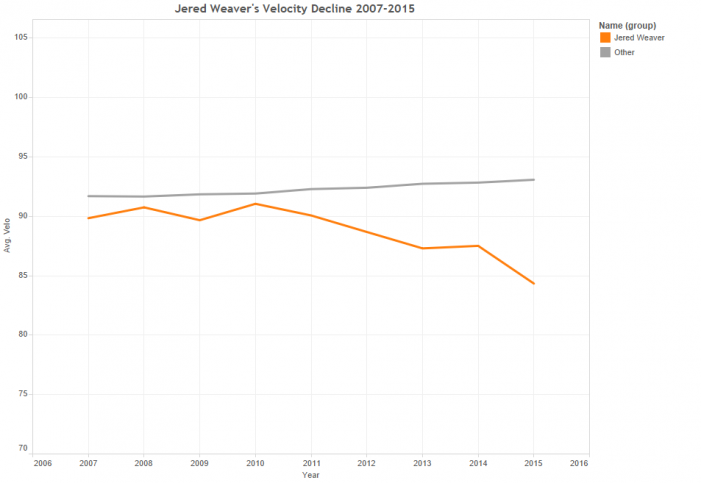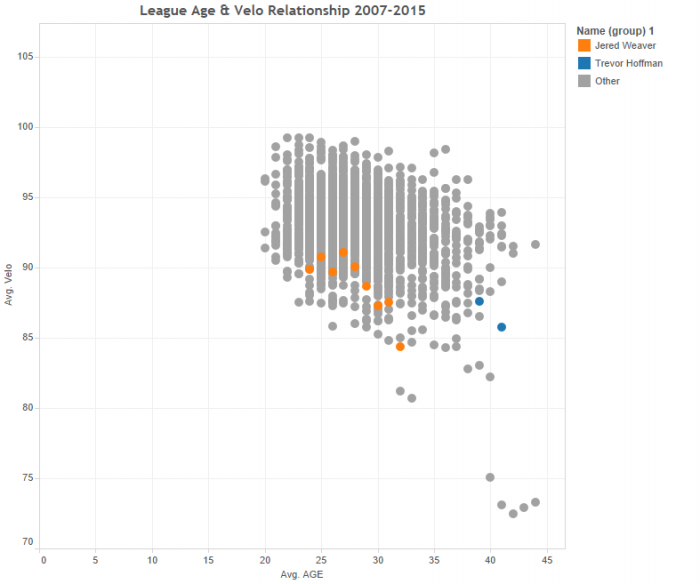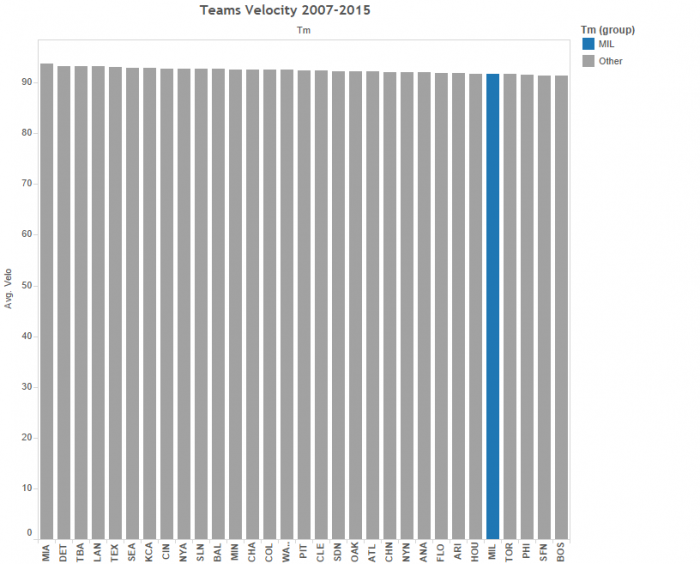It’s spring training and some storylines are already starting to filter throughout the blogosphere. The St. Louis Cardinals need a shortstop after Jhonny Peralta injured his thumb, Jose Bautista wants more money than major-league teams want to pay him, and Jered Weaver is doing his best Jamie Moyer impression on the mound.
Reports suggest that Weaver’s fastball averaged at 79 mph and never passed 81 mph in his most recent start. Considering the rise in fastball velocity throughout Major League Baseball over the past few years, that number is staggeringly low. Here’s a visual representation of how Weaver’s fastball velocity relates to the rest of the league:
From 2007 to 2015, the average fastball velocity across the league has increased from 91.64 to 93 mph. Jered Weaver’s fastball, on the other hand, has decreased from 89.8 mph in 2007 to just 84.3 mph last year. What’s even more interesting is that Weaver’s fastball from 2010 to 2013 went down by an average of 1 mph per year. From 2013 to 2014 it plateaued a bit, and then last year it took a nosedive by 3 mph. Barring injury, that’s pretty insane. And now, reports suggest that his fastball is regularly clocking in at 79 mph.
If any minor-league pitcher was caught throwing 80 mph, he’d quickly be labeled a non-prospect. If a collegiate pitcher threw 80 mph and didn’t have an obscenely weird arm slot, he wouldn’t get a lot of scouting attention for the MLB Draft. If a prep pitcher was throwing 80 mph in high-school games or showcases, he wouldn’t even get a second look from big-league clubs.
Hell, when I played baseball, I’m pretty sure I played against people who threw 80 mph. We didn’t have any radar guns, so I might be mistaken. You know what, I’m probably mistaken. Scratch that, I’m definitely mistaken, but my god, 79 mph!
Granted, it’s just the start of spring training. Weaver’s fastball is so slow that it probably has an arc, but there’s still a chance it picks up velocity. With that said, once pitcher’s start to lose velocity, they don’t tend to get it back, especially as they’re getting older. What’s even more surprising about Weaver’s fastball is that since the PITCHfx era, there hasn’t been a right-handed pitcher that’s thrown that softly at Weaver’s age (32).
Sure, there are some outliers and exceptions. Chad Bradford perhaps being the most notable one, who in 2007 and 2008 threw 81 mph on average, but Bradford threw underhand. Then there’s Tim Wakefield and R.A. Dickey, but they’re knuckleball pitchers and they were both older than Weaver when they threw in the big leagues. Finally, we have Livan Hernandez, who never threw very hard. Even at the age of 32, he only threw 85 mph. Weaver clocked in at 84 mph, but Hernandez was able to keep that velocity until he was 37 years old. If the spring-training velocity readings hold, then Weaver will truly be an anomaly.
The next questions to answer are the following: Has Weaver’s loss in velocity affected his performance? Will it affect his performance going forward?
For most of his career, the answer can be described as no. Or, at least, he’s been able to provide above-average performance despite his slow fastball. One of the reasons he has been able to produce is that he simply doesn’t throw it very often. Since the 2012 season, he hasn’t thrown his fastball more than 30 percent of the time.
But, at some point, common sense suggests that his velocity drop is going to have an affect on his overall performance, and last year may have been the tipping point. Never before had Weaver had a below average DRA, but last year, with his 3 MPH drop he did. And unfortunately for Weaver, his fastball got crushed last year. There simply aren’t many major-league pitchers who have had success throwing that slowly. Maybe Weaver is the ultimate outlier. Maybe he’s the anomaly. But I think, at this point, we shouldn’t expect Weaver to be anything more than a back-of-the-rotation starter, and he’d probably be lucky to be that.
Another note from the above graph: Trevor Hoffman’s 2009 season with the Milwaukee Brewers. It’s something that I have discussed briefly in the past. The interesting part about this information, though, is that no pitcher since the PITCHfx era has had as much success as Trevor Hoffman while throwing that slowly.
There’s a very good chance Hoffman will make it into the Hall of Fame. He’ll probably go in as a San Diego Padre, which is reasonable as he played sixteen of his eighteen seasons in the big leagues with that franchise. But what most people probably don’t know is that arguably his best season came with the Brewers. His 31.8 DRA- was never better than that season, and it still stands as the greatest DRA- in Brewers history. Hoffman was a closer, though, so obviously that gave him a bit of an advantage over the franchise’s starting pitchers.
It’s hard to say exactly what changed for Hoffman. The most notable element was that hitters weren’t making contact with his pitches outside the strike zone (48.8 percent contact rate outside the zone). Hoffman also started throwing more pitches middle-down and off the plate. However, hitters simply didn’t swing at many of Hoffman’s pitches outside the zone. With that said, Hoffman benefited from a very low BABIP at .228, a high strand rate (82.6 percent) and a low HR/FB ratio (3.1 percent). The right-hander had a reputation for inducing weak contact for most of his career, given his trademark changeup, which is evidenced by his .263 career BABIP. He probably benefited from some luck, but in only 54 innings pitched, that’s not unreasonable.
The Brewers, as an organization, also haven’t benefitted from many flame-throwers, at least not since the 2007 season.
They rank as the 25th team in velocity since that point, and since 2007, they’ve only had 11 pitchers who have had an average fastball of more than 95 mph and none who have averaged more than 97 mph. What makes this worse is that teams such as the Red Sox and Blue Jays have their data skewed because they’ve had knuckleball pitchers on their staffs. If I excluded Tim Wakefield and R.A. Dickey from the data, then Milwaukee would find themselves in 27th place.
Velocity isn’t the only measure of success. Pitchers who throw hard aren’t destined for greatness. But, it definitely helps, and having many pitchers who throw hard in the big leagues won’t hurt. Just take a look at the Mets — practically all of their young starters throw hard, and they have one of the most highly regarded pitching staffs in Major League Baseball.
In the end, as the Brewers move forward with their rebuild, it will be interesting to see whether they increase they’re attention on pitchers who throw hard, as it has clearly been a challenge for the organization thus far.
BONUS INTERACTIVE DATA: Brewers Velocity, Age, and Performance 2007-2015




